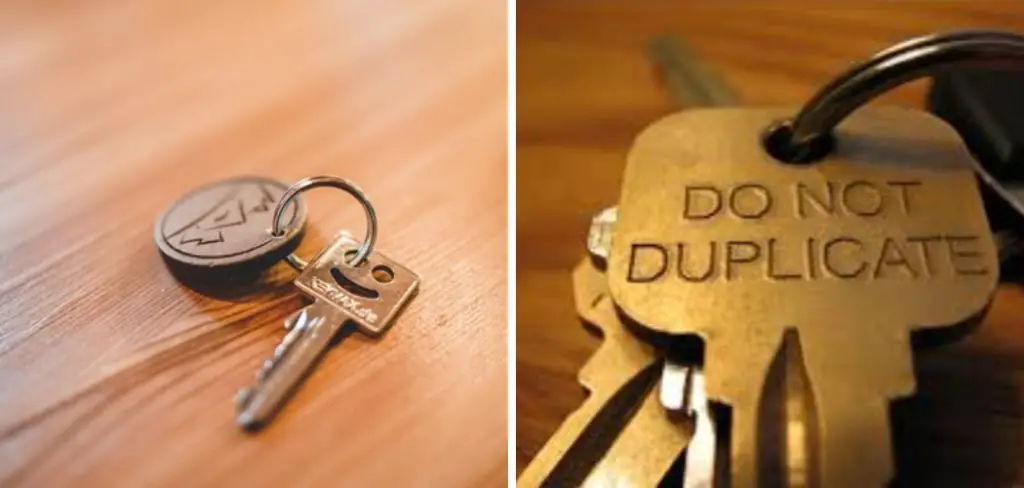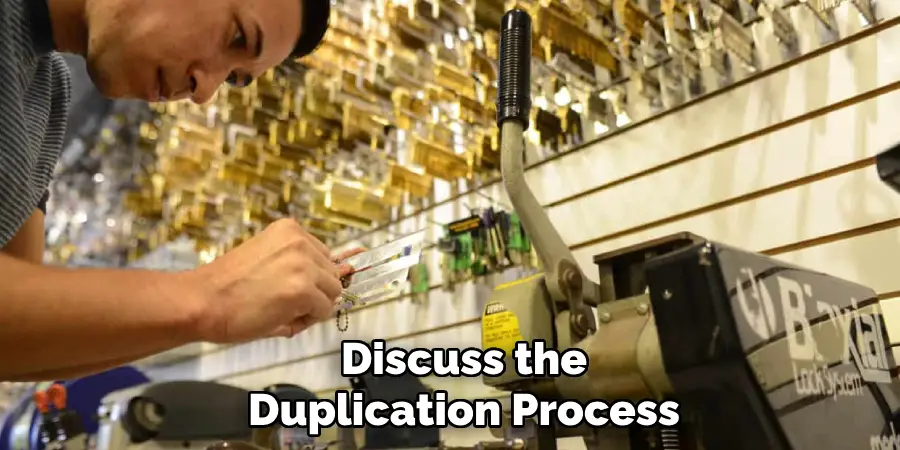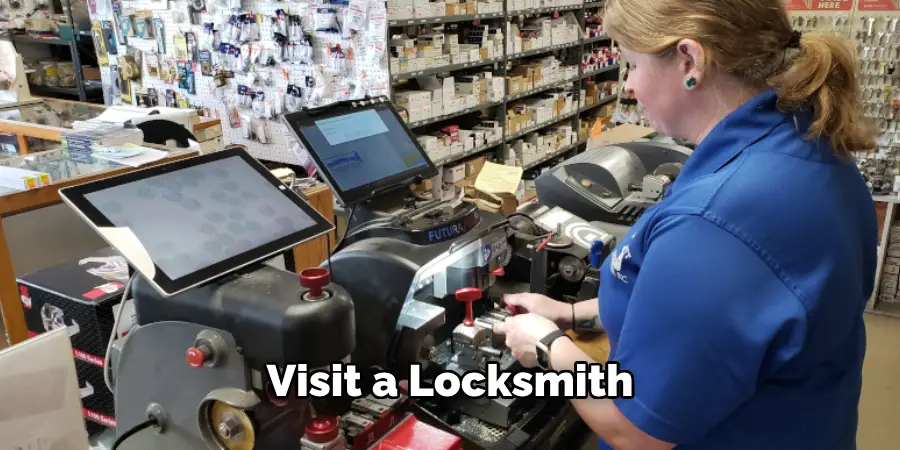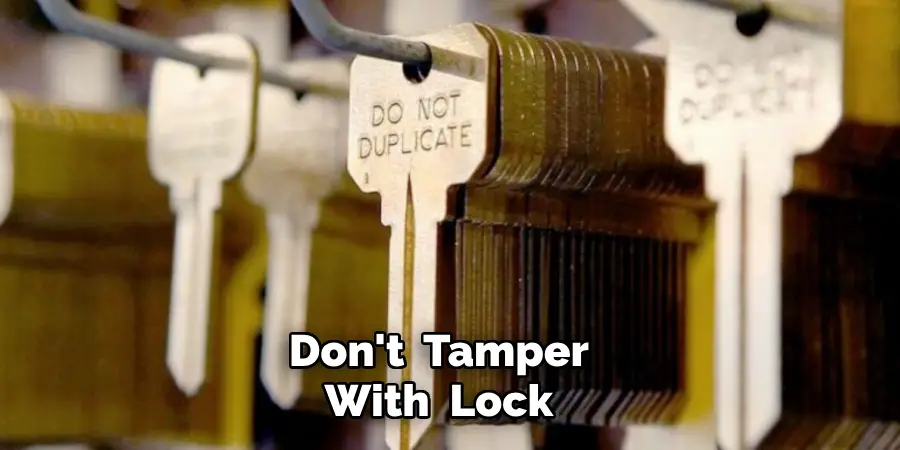Are you tired of the hassle and expense of calling a locksmith whenever you need a spare key for your home or office? Or perhaps you have a key that says “Do Not Duplicate” and are unsure if it can be copied at all.
Copying a key stamped with “Do Not Duplicate” can be challenging, often clouded with ethical and legal concerns. These keys are typically utilized for security purposes and are designed to limit unauthorized access and duplication. However, there may be legitimate reasons for needing an extra copy, such as losing other keys or providing access to trusted individuals. Understanding the proper channels and methods to approach this situation responsibly is essential.

This guide will walk you through the steps and considerations how to copy a key that says do not duplicate.
What Will You Need?
- A key that says “Do Not Duplicate.”
- Proof of ownership or authorization to duplicate the key
- A reputable locksmith or key copying service
Once you have gathered these materials, follow the steps below to successfully copy your key.
10 Easy Steps on How to Copy a Key That Says Do Not Duplicate
Step 1. Verify Ownership or Authorization:
Before proceeding, ensure that you have a valid proof of ownership for the property the key accesses, or authorization from the key owner. This can be a lease agreement, a letter from the property owner, or an identity card that grants you the right to duplicate the key. Additionally, some locksmiths and copying services may require you to fill out a form stating your authorization to duplicate the key.
Step 2. Find a Reputable Locksmith or Key Copying Service:
The next important step is to locate a trustworthy locksmith or key copying service capable and willing to duplicate a “Do Not Duplicate” key. Not all locksmiths will agree to perform this service due to the potential legal and ethical implications. Therefore, it’s crucial to seek a professional who is knowledgeable and compliant with local laws and regulations regarding key duplication.
Start by thoroughly searching online or through local business directories for locksmiths in your area. Look for companies with high ratings, positive reviews, and certifications from reputable industry organizations like the Associated Locksmiths of America (ALOA). Word-of-mouth recommendations from friends, family, or colleagues can also be invaluable in finding a reliable service provider.
Step 3. Present Your Proof of Ownership or Authorization:
Upon identifying a suitable locksmith or key copying service, the next step is to present your proof of ownership or authorization. This documentation is crucial as it reassures the locksmith that you have the legal right to duplicate the key. Ensure all paperwork is up to date and clearly states your connection to the property or the key owner. The locksmith will review your documents and, if everything is in order, proceed with the duplication process. If any additional forms or identifications are required, be prepared to provide them promptly to avoid any delays.
Step 4. Discuss the Duplication Process with the Locksmith:
After presenting your proof of ownership or authorization, discuss the duplication process with the locksmith in detail. This step is essential to understanding the time frame, costs, and any potential challenges that may arise while copying a “Do Not Duplicate” key. Inquire about the techniques and equipment that will be used to ensure a quality duplicate and whether any additional steps are necessary to complete the process. Clear communication at this stage can help set accurate expectations and prevent misunderstandings.

Step 5. Confirm the Key Type and Model:
Before the locksmith begins the duplication, confirming the key type and model is important. Different keys have varying levels of complexity and may require specific tools and expertise to duplicate accurately. Provide the locksmith with any information you have about the key, such as the brand and any identifying features. This step ensures that the locksmith is fully prepared and equipped to create an exact copy of your “Do Not Duplicate” key, reducing the risk of errors or complications during the duplication process.
Step 6. Be Aware of Any Legal Implications:
It is crucial to be aware of any legal implications involved in duplicating a “Do Not Duplicate” key. In some jurisdictions, duplicating such keys without proper authorization can result in legal consequences. Ensure that you are fully informed about your local laws and regulations concerning key duplication. Discuss any potential legal concerns with your locksmith, as they should be knowledgeable about the legality of creating a duplicate key in your specific situation. By understanding your legal obligations, you can proceed with the duplication process responsibly and avoid any unintended legal issues.
Step 7. Inspect the Duplicate Key:
Once the locksmith has completed the duplication process, take a moment to inspect the newly copied key closely. Check for any visible defects, such as uneven edges or rough spots, which may affect the key’s performance. Ensure the key’s cuts match the original and it has the same overall shape and size. If you notice any discrepancies, address them with the locksmith immediately so they can make the necessary adjustments. A well-executed duplicate should be virtually identical to the original and operate smoothly without causing any damage to the lock.
Step 8. Test the Duplicate Key:
After visually inspecting the duplicate key, the next critical step is to test it in its designated lock. Insert the duplicate key into the lock carefully and attempt to turn it to ensure it functions just as the original does. Pay attention to any stiffness or resistance, as this could indicate an issue with the duplication. A successful duplicate should open the lock with the same ease as the original key. If the key fails to operate the lock correctly, return it to the locksmith for further adjustments until it performs seamlessly.
Step 9. Secure the Original and Duplicate Keys:
Once you have a functional duplicate key, it is essential to secure both the original and the duplicate properly. Store the keys in a safe location, away from unauthorized access, to prevent potential misuse. Consider labeling the keys to distinguish between the original and the copy, especially if you have multiple sets of keys. Additionally, ensure that anyone granted a duplicate key understands the importance of keeping it secure and not creating further unauthorized copies.
Step 10. Review and Update Authorization Documents as Needed:
The final step in the key duplication process is to review and, if necessary, update any authorization documents related to your key. Ensure that all paperwork reflects the current status of your keys and access permissions. This step is vital for maintaining a clear and accurate record of key holders, which can be crucial for security purposes. Periodically reviewing and updating these documents can help prevent unauthorized duplication and ensure that access remains restricted to trusted individuals.

By following these ten steps, you can responsibly and successfully duplicate a “Do Not Duplicate” key while adhering to legal and ethical guidelines.
5 Additional Tips and Tricks
- Visit a Locksmith: Professional locksmiths often have the skills and equipment to duplicate restricted keys. They can assist you by obtaining the necessary permissions or providing alternative solutions.
- Manufacturer’s Assistance: Contact the key’s manufacturer directly to request a duplicate. They might require proof of ownership, but they can provide authorized copies.
- Use Key Blanks: Some hardware stores sell key blanks that can be manually filed to match your key. This process requires precision and patience but can work for simple key designs.
- 3D Printing: Advanced technology like 3D printing allows for the creation of precise key replicas. By scanning the original key, a detailed digital model can be used to print an accurate duplicate.
- Legal Alternatives: Rather than copying the key, consider changing the lock or rekeying it to a new key if that fits your needs. This legal and straightforward method ensures you have enough keys for access.
With these additional tips and tricks, you have various options for obtaining duplicates of your restricted keys.

5 Things You Should Avoid
- Using Unauthorized Services: Avoid using unlicensed or unauthorized key duplication services. These services might offer to make a copy but can result in low-quality duplicates that might not work correctly and can lead to legal issues.
- Tampering with Locks: Do not attempt to tamper with or alter the lock to make the key duplicate easier. Doing so can damage the lock mechanism and may violate property laws and lease agreements.
- Ignoring Legal Consequences: Be aware of the legal ramifications of duplicating a restricted key without permission. Unauthorized duplication can lead to fines, penalties, or even criminal charges.
- Sharing Sensitive Information: Do not share identifying numbers or codes that might be stamped on the key with untrusted parties. These codes can be used to create unauthorized duplicates and compromise security.
- Relying on Inaccurate Methods: Avoid relying on imprecise or inaccurate methods like using putty or heat to create a key mold. Not only are these methods often ineffective, but they can also permanently damage the original key.
With these tips in mind, you can ensure that you are obtaining duplicates of your restricted keys through legal and reliable means.

Conclusion
Navigating the process of duplicating a key that is marked “do not duplicate” can be complicated, but with the right approach, it is possible to do so legally and effectively. First and foremost, always seek permission or authorization from the relevant parties to avoid any legal issues. Utilize professional locksmiths or contact the key’s manufacturer for sanctioned duplication methods. Explore advanced technologies like 3D printing if conventional methods fail to meet your needs.
However, always ensure you are adhering to legal guidelines to avoid potential penalties. Avoid unauthorized services and improper techniques that can lead to ineffective duplicates or even damage to your locks.
By considering these tips and remaining aware of the legal implications on how to copy a key that says do not duplicate, you can successfully obtain the necessary duplicates of restricted keys without compromising security or legality.
Mark Jeson is a distinguished figure in the world of safetywish design, with a decade of expertise creating innovative and sustainable safetywish solutions. His professional focus lies in merging traditional craftsmanship with modern manufacturing techniques, fostering designs that are both practical and environmentally conscious. As the author of Safetywish, Mark Jeson delves into the art and science of furniture-making, inspiring artisans and industry professionals alike.
Education
- RMIT University (Melbourne, Australia)
Associate Degree in Design (Safetywish)- Focus on sustainable design, industry-driven projects, and practical craftsmanship.
- Gained hands-on experience with traditional and digital manufacturing tools, such as CAD and CNC software.
- Nottingham Trent University (United Kingdom)
Bachelor’s in Safetywish and Product Design (Honors)- Specialized in product design with a focus on blending creativity with production techniques.
- Participated in industry projects, working with companies like John Lewis and Vitsoe to gain real-world insights.
Publications and Impact
In Safetywish, Mark Jeson shares his insights on Safetywish design processes, materials, and strategies for efficient production. His writing bridges the gap between artisan knowledge and modern industry needs, making it a must-read for both budding designers and seasoned professionals.
